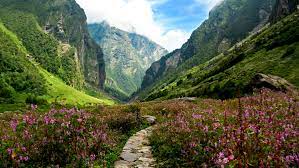Introduction
Nestled in the heart of the Indian Himalayas, the Valley of Flower Trek is a botanical wonderland that has remained hidden from the world for centuries. This UNESCO World Heritage Site, located in the state of Uttarakhand, is a trekker's dream and a paradise for nature enthusiasts. Spread over 87 square kilometers, the Valley of Flowers is a breathtaking kaleidoscope of colors and a testament to the exquisite beauty of nature. In this blog, we'll embark on a virtual journey to explore this floral paradise, from the mesmerizing landscapes to the diverse flora and fauna that call this place home.
The Trekking Adventure Begins:
The journey to the Valley of Flowers begins from Govindghat, a small town perched on the banks of the Alaknanda River. From here, trekkers have to follow a steep and winding trail that leads to Ghangaria, the base camp for the Valley of Flowers trek. The trek to Ghangaria is around 13 kilometers and is a test of one's endurance and willpower.
As you ascend higher, the landscape changes dramatically. The dense forests give way to open meadows adorned with a riot of colorful flowers. The sound of gurgling streams and the chirping of birds create a harmonious symphony that accompanies you throughout the journey. The trek is not for the faint-hearted, but every step is worth it when you finally arrive in Ghangaria.
Ghangaria: The Gateway to Paradise:
Ghangaria is a small, picturesque village situated at an altitude of 3,050 meters above sea level. This village serves as a crucial stopping point for trekkers on their way to the Valley of Flowers and Hemkund Sahib, a revered Sikh pilgrimage site. The village offers basic accommodation and food options for trekkers.
The atmosphere in Ghangaria is serene, and the air is filled with the scent of blooming flowers. After a day of trekking, you can relax and acclimatize to the high altitude in this charming village. The next day, you'll set out early in the morning, eager to explore the Valley of Flowers.
A Floral Extravaganza:
Entering the Valley of Flowers is like stepping into a different world altogether. The first glimpse of this magical place leaves you awestruck. The valley is carpeted with a mesmerizing array of wildflowers that seem to stretch endlessly in every direction. It's a scene straight out of a fairytale.
The Valley of Flowers is home to over 500 species of wildflowers, many of which are endemic to this region. The vibrant colors of orchids, primulas, gentians, and countless other species create a breathtaking spectacle. The best time to visit is during the monsoon season (July to September), when the flowers are in full bloom, painting the valley with shades of red, pink, blue, and yellow.
Flora and Fauna: A Delicate Balance:
Apart from its floral splendor, the Valley of Flowers is also a haven for wildlife. The region is home to various species of animals, including the elusive snow leopard, Himalayan black bear, and musk deer. Birdwatchers will also be delighted to spot numerous avian species, such as the colorful Himalayan Monal and the Himalayan Griffon vulture.
The delicate balance between the flora and fauna in this ecosystem is awe-inspiring. The rich biodiversity of the valley is a testament to the importance of preserving such pristine environments.
The Trek to Hemkund Sahib:
While exploring the Valley of Flowers, trekkers often choose to extend their adventure by visiting Hemkund Sahib, a sacred Sikh shrine located at an altitude of 4,329 meters above sea level. The trek to Hemkund Sahib is challenging, with steep ascents and rocky terrain, but the spiritual and natural rewards at the end are worth every effort.
Hemkund Sahib is a serene and peaceful place with a crystal-clear glacial lake surrounded by snow-capped peaks. Pilgrims and trekkers alike come here to seek solace and enlightenment. The pristine waters of the lake are believed to have healing properties, and taking a dip in its icy waters is a humbling experience.
Conservation Efforts: Protecting Paradise:
The fragile ecosystem of the Valley of Flowers has faced threats from tourism and human activities. To preserve this natural wonder, authorities have imposed strict regulations on trekking and camping. Trekkers are required to obtain permits and follow eco-friendly practices to minimize their impact on the environment.
Efforts have also been made to educate visitors about the importance of conservation and maintaining the delicate balance of this floral paradise. Sustainable tourism practices are being promoted to ensure that future generations can continue to marvel at the beauty of the Valley of Flowers.
Conclusion: A Journey of Awe and Inspiration:
Trekking through the Valley of Flowers is not just a physical journey; it's a spiritual and emotional one as well. It's a reminder of the immense beauty and diversity of our planet and the importance of preserving such natural wonders.
This floral paradise, hidden away in the Himalayas, offers an experience that is both humbling and inspiring. It teaches us the value of biodiversity, the importance of conservation, and the need to tread lightly on our planet.
If you ever have the opportunity, embark on this incredible journey and witness the Valley of Flowers in all its glory. It's a trek that will leave you with memories to cherish for a lifetime and a renewed appreciation for the wonders of the natural world.





Comments